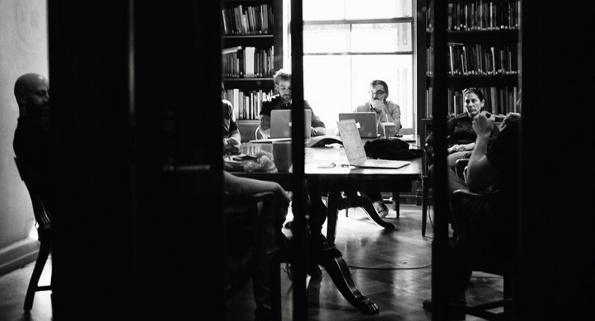Code and Theory on the meaning of disruption
From Vogue to Dr Pepper, Code and Theory has had its share of famous clients. Key team members chat to Martin Cooper about landing the big fish, reading for success and more
.net: Let’s start with an easy one: was there a defining moment or project for the agency?
Dan Gardner: Early in Code and Theory (C&T)’s history we designed the Sony Classical VIP site, which was big for us at the time. It was also ground-breaking for the industry: we were one of the first companies to use Flash video recognised on the Macromedia homepage. When we launched Style Wars celebrating the DVD re-release of the 1980s hip-hop documentary, we got a lot of recognition including a Webby, Horizon Interactive Award and a SXSW award. Starting a relationship with Comcast significantly expanded our services beyond web to platforms like TV and mobile, as well as evolving away from Flash websites. And launching the Daily Beast was key too – it brought us notoriety in the publishing world. We learned so much from working with Tina Brown in the process, which still informs our design thinking today on, not only the publishing sites but, brand experiences we work on.
.net: How did you come by the name?
Brandon Ralph: I wanted to teach a class in college, before leaving NYU, called Conceptual Design Through Code and Theory. When Dan and I started the company, a good friend suggested we use it.
.net: How large is the company now?
DG: About 175 people across three offices: New York City, San Francisco and Manila. We still feel like a small family company that happens to be a bit larger.
.net: Your client roster reads like a who’s who of the Dow Jones’ finest. How do you land such big fish?
Michael Martin: We have a constant focus on delivery. When we meet a potential client, we take them through some of our portfolio pieces, focusing less on the literal outcome; more on the client challenge and our strategic approach. We’re fans of sketching out ideas and concepts in meetings: that gives clients the comfort that we are passionate about the work we do and have a track record of delivering. We seek clients with compelling products and services who are a good cultural fit with us: it’s key to attracting and retaining some of the industry’s best. Market capitalisation and annual digital spend do not drive who we go after. We look for innovative companies that we think can be pushed even further, and work collaboratively to find the right path.
.net: ‘Disruptive’: what does it actually mean? And what’s the secret of getting it right?
DG: First, in an industry like ours, there are ‘best practices’. At a tactical level we strive to challenge the notion of what ‘best practice’ is, vs what’s just familiar. Second, to be disruptive, you have to think about what kinds of creative ideas can shift the course of the project or industry you’re working in. You shouldn’t focus on being different for the sake of it. You should think about opportunities you can capitalise on and where you can create differentiation. It should always be in context to what success looks like for the client. Often it requires instinctual rather than data-driven decisions.

.net: With such a wide variety of clients, how do you make the conceptual and creative leap from, say, Vogue one month to Dr Pepper the next?
BR: It always starts with a communication challenge. Each brand has its assets, stories, heritage and, most important, customers. You need to adapt the design so it’s appropriate to the brand or brand voice.
.net: What advice would you give a smaller agency looking to make it big?
BR: It’s important to trust your instincts and have the humility to acknowledge when a decision is wrong, and make sure to fix it quickly. If all else fails, just work harder than everyone else and some how it usually works out in the end.
.net: Is there a secret to working smoothly with super demanding clients?
Mike Treff: There’s no secret and, while there are extremes, each client presents their own challenges: business-related, creative or organisational. As we’re so demanding on ourselves, we understand demanding clients, especially from a creative perspective. That usually leads to the best work. With respect to the process of working together, it has been my experience that the best way to deal with demanding clients is to be transparent and over-communicative. Most relationship difficulties come from a lack of understanding of the issues, complications, expectations or goals. Therefore, communicating early and often seems to take the reactiveness and anger out of the equation.
Steve Baer: The challenge with demanding clients is to balance the desire to work smoothly with the goal of doing great work. So, it is really important to establish and build trust with clients – it will help you to say “no” in a constructive way if you don’t think the direction you are heading in is the best one. It’s also important to understand clients’ particular challenges, structures and processes. We try to map to the client while staying true to ourselves. It’s a difficult balancing act.
.net: How closely do you work with your clients?
MT: It depends on the project and the relationship. We come from a perspective that the more we’re able to understand the goals, challenges, aspirations and frustrations of our clients, and our clients’ customers, the more effectively we can solve their problems. For example, with our publishing clients we try to embed our team in the newsroom and tech division as much as possible during our definition phases. This way, we can understand workflow and pain points in the editorial and storytelling process. But there’s a point where some separation is good. We do need time to think about potential solutions and then come back to our clients with fresh thinking.
SB: We think it’s really valuable to bring an outsider’s perspective on things. This is not to say we don’t immerse ourselves in their brands, briefs or audiences; we do this, but we are always C&T. Sometimes clients will use us to make a point to their teams that they can’t make themselves. When it comes from ‘the experts’, as they refer to us, co-workers are more apt to accept the points being made. I think being truly embedded would lead to a great deal of conflict for those individuals in terms of decision-making and alignment. However, I think there are probably certain instances where it can happen successfully.
.net: Web standards vs apps. Do you see a winner?
DG: When apps first came out I saw an analogy with the 90s when shareware/freeware was huge. All of that moved online; much more could be accomplished via the browser. When mobile apps came out, it seemed we all had reverted back to the shareware days. Today, we’re all getting much more sophisticated about how to deliver that same value through the mobile web browser to take advantage of web-based delivery. That said, there’s still a role for software on your computer and there’s still a role for software in-app. You have to consider the whole ecosystem and opportunities and benefits for each.

.net: The internet of things. Do you see it changing design and development?
Joshua Davis: Absolutely: 15 years ago, computing was a closed environment. Physical things, like a calculator or an alarm clock, were produced by a manufacturer and you could only use that ‘thing’ in one capacity. As more information moves to the cloud, more objects become internet-connected and more people have access to them, I think there will be an explosion of applications that can perform hyper-specific tasks appealing to very finite communities. Like a coffee maker that makes coffee when I send my first tweet of the day. Maybe only 10 people would use it, but that will be OK. There will no longer be a need for large companies to make these design and development innovation decisions anymore. At this point, we can allow the consumers of a brand to help define it.
.net: Who’s impressing you right now?
MT: Brian Roettinger, an amazing artist and designer in Los Angeles who’s worked on everything from artist monographs for Aaron Curry and Andy Warhol, to original paintings for Saint Laurent, to artwork and packaging for incredible bands like No Age and Liars. I believe Todd Hido (www.toddhido.com) to be the most inspiring photographer working today. Whether landscape shots through the frozen window of a car in the backroads of rural towns, or portraiture shots in deserted motels, his work is always original. No Mas is some of the best curated street and sports-related apparel ever made. Nowhere else can you find the classic Costacos Bros’ LA Law poster immortalised on a T-shirt. And finally, Lindsay Adelman: her lighting is sculpture. Plain and simple.
.net: What advice would you give an ambitious young designer or developer looking to join you?
JD: My best advice is to not listen to advice. When I was starting out, I read three books that really inspired me. The first is [Paulo Coelho’s] The Alchemist: it’s about knowing your path. The second is The Fountainhead, because it taught me to not be a copier like Peter Keating; it inspired me to be the impossible, like Howard Roark. The third is Think and Grow Rich, which was commissioned by Andrew Carnegie. The reason I loved it is because it had great lessons about failure and how it only occurs before success. My advice is to read these three books, find your path and walk it, and take risks.
.net: What’s the formula for success?
BR: If you have a formula for success, you’re not very entrepreneurial. Good entrepreneurs constantly change what success means to them. At C&T, it’s been an evolving goal for us to adapt our thinking and strategies based on new tools, brands and technologies. It’s all about working in real time to stay ahead of everything that’s appropriate for our clients – not just jumping on the latest fad.
.net: What’s the biggest lesson you’ve learned along the way?
BR: One of the biggest lessons I’ve learned is that you’re really only as good as your next project. Another is that you have to look forward rather than left and right for inspiration.
DG: C&T has evolved a lot since the early days. The biggest thing I’ve learned from building and running a company is that there’s no right way to do it. I think limiting yourself to listening to others tell you how you should do it doesn’t allow you the freedom to evolve and create differentiation. Steal what feels right and invent everything else. Another thing I learned is to never be afraid to take risks.
Our work

Thank you for reading 5 articles this month* Join now for unlimited access
Enjoy your first month for just £1 / $1 / €1
*Read 5 free articles per month without a subscription

Join now for unlimited access
Try first month for just £1 / $1 / €1
Get the Creative Bloq Newsletter
Daily design news, reviews, how-tos and more, as picked by the editors.

The Creative Bloq team is made up of a group of art and design enthusiasts, and has changed and evolved since Creative Bloq began back in 2012. The current website team consists of eight full-time members of staff: Editor Georgia Coggan, Deputy Editor Rosie Hilder, Ecommerce Editor Beren Neale, Senior News Editor Daniel Piper, Editor, Digital Art and 3D Ian Dean, Tech Reviews Editor Erlingur Einarsson, Ecommerce Writer Beth Nicholls and Staff Writer Natalie Fear, as well as a roster of freelancers from around the world. The ImagineFX magazine team also pitch in, ensuring that content from leading digital art publication ImagineFX is represented on Creative Bloq.
